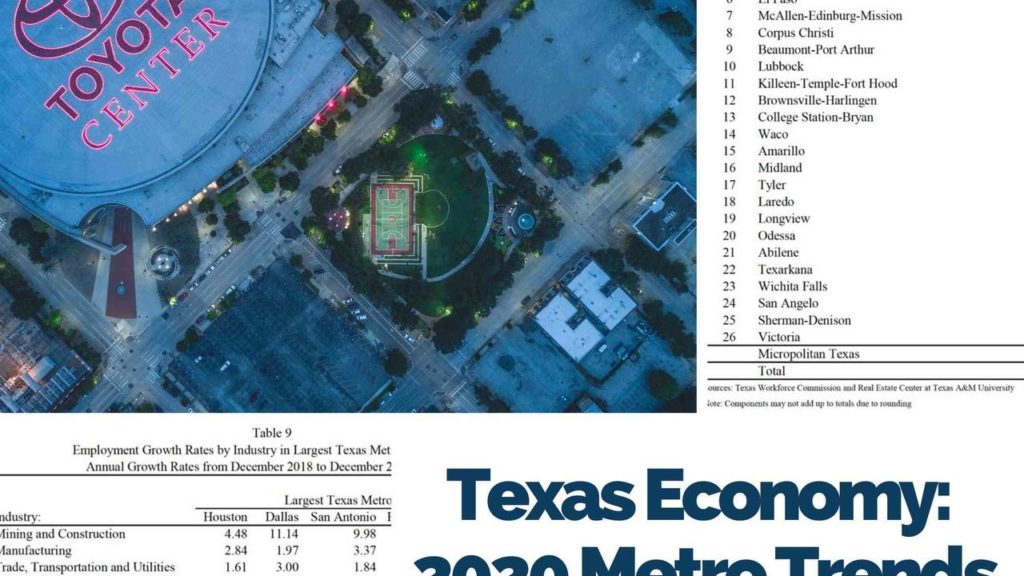
Helpful Links:
Overall in 2019, the economic conditions throughout Texas proved strong, resulting in conditions that attracted companies and migrants from other states. The Real Estate Center at Texas A&M in a 2019 annual summary, stated that “the labor market remained strong with record-low unemployment, stable job growth, and improved labor force participation, although initial unemployment claims rose modestly.”
A 2018 study was recently released showing that the largest metros in the state comprised more than 60% of the state’s GDP. Houston’s economy was second behind Dallas-Fort Worth. The Houston MSA increased 3% in 2018 and was able to recover above pre-oil bust levels after accounting for inflation.
Texas A&M — Real Estate Economy Report
In the last 12 months, Texas has continued to create jobs faster than the nation’s average. Since 2018, the state has added 342k nonagricultural jobs at an annual growth rate of 2.7% (nation’s employment growth rate is 1.4%). The nongovernment sector added roughly 328k jobs at an annual growth rate of 3.1% (U.S. average: 1.5%). Texas also had a seasonally adjusted unemployment rate of 3.5% in Dec 2019 (lower than their 3.7% rate Dec 18)—while the U.S. rate decreased from 3.9% to 3.5% in that same time period.
Employment Growth Rates in Texas Metros
All but four metros had more jobs in Q4 2019 than Q4 2018 (see below). The Houston-The Woodlands-Sugar Land metro, which contains our multifamily fourplex project in Cypress, came in at #5 with a recorded 2.9% increase.

Texas Job Shares by Metro
“Table 6 shows Texas metropolitan areas ranked by their shares of total Texas jobs in December 2019. Houston-The Woodlands-Sugar Land had the largest share of Texas jobs followed by Dallas-Plano-Irving, Austin-Round Rock, San Antonio-New Braunfels, Fort Worth-Arlington, El Paso, and McAllen-Edinburg-Mission.”
Contribution to TX Employment Growth Rate by Metro
The growth rate of 2.71% statewide in Texas is the weighted average of employment growth rates of all Texas metros for the period (Dec 18-Dec 19). Weights are shares of jobs by area. “The contribution of each metro to the statewide employment growth rate is equal to the employment growth rate in that area multiplied by its share of Texas jobs.” The Houston metropolitan area came in at second, with Dallas leading the way when compared to all other metros.

Employment Growth Rates by Industry in Largest Metros
This table breaks down the annual growth rates of each employment industry and compares them to Texas’ six largest metros, Houston, Dallas, San Antonio, Fort Worth, Austin, and El Paso.
Houston-The Woodlands-Sugar Land is currently experiencing positive employment growth rates in the government sector and in all industries except information. We break down some of this growth in our Houston market report which you can get for free on this site.

Real Estate Investing in the Houston Metro
We love the Grand Parkway that is now connecting the north side of the Houston metro with the Westside. This has spurred more and more growth up and down the parkway. For our location in Cypress, this is key to our fourplex investments. We also think the widening of Highway 290 is going to do great things for the economy.
The North-West Houston metro is becoming more accessible than it has ever been. With good schools in the area and plenty of jobs in Houston, we’ll continue to see a demand for affordable multifamily housing that can help offset the glut of class-A apartment buildings that have swept the metro over the last decade.
